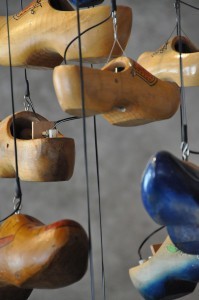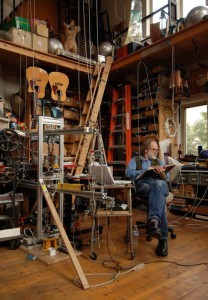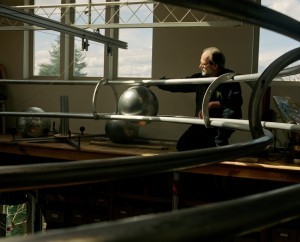
Reposted from MIT News
Trimpin — he goes by his surname only — first immigrated to the United States in 1979 because there was not enough junk in his native Germany. In the scrapyards and Boeing surplus stores in Seattle, he found enough discarded electronic parts to create the kinds of visionary musical devices — part instrument, part kinetic sculpture — that eventually won him a MacArthur “genius” grant in 1997.
On April 17, Trimpin gave a public lecture-demonstration as part of the course “Music and Technology,” sponsored by the Center for Art, Science & Technology (CAST). After the talk, audiences of all ages — the youngest still in elementary school — flocked to the eclectic range of contraptions he exhibited, eager to try them out.

A generation earlier, the legendary composer and instrument builder Harry Partch, who inspired Trimpin, once referred to himself as “a philosophical music-man seduced into carpentry.” This description also holds true for the self-taught tinkerer Trimpin. Although Trimpin was born into a musical family, his rare allergy to metal prevented him from playing traditional instruments. And so he began to create his own acoustic sounds, in the beginning dismantling and reassembling all the town’s old radios before moving on to design computer-controlled devices.
The results are ingenious feats of electromechanical engineering that combine a sense of humor with adroit technical execution — such as a 60-foot stack of guitars, or a “FireOrgan” in which sound is produced by blowing warm air up a series of glass pipes using a Bunsen burner. Trimpin has also converted the complex piano roll compositions of Conlon Nancarrow into MIDI files to play on other mechanical instruments, saving them from becoming obsolete when Nancarrow’s old player pianos died.

In one project, he invented a computer-controlled device that allowed Nancarrow’s work to be played by mallets striking 100 Dutch clogs. Such unusual materials abound in his work as he employs everything from duck calls to saw blades to pottery wheels.

The sheer eccentricity of Trimpin’s instruments can sometimes belie the seriousness of their investigations into the spatial, kinetic, acoustic and phenomenological aspects of sound. While the instruments offer opportunities for playful interaction, they also represent complex feedback loops that seek to replicate the kinds of sonic environments found in nature. To reproduce “the beautiful rhythmic patter” of a raindrop on a branch, Trimpin said, involves the consideration of many parameters not ordinarily perceived, such as gravity and temperature. “How can you recreate something you experience?” he asked the audience. “How can you use technology to do this?”
While at MIT, Trimpin visited the Glass Lab and mentored small groups of students as they developed their own musical devices. He gave in-depth, personalized feedback for every phase of the creative process, from the initial stages of project design to recommendations for technical modifications. Trimpin’s visit was an inspiration for students interested in creating sound not just for the ears, as he described it, but for the whole body.

